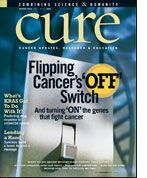To Screen or Not to Screen
Controversy surrounds lung cancer screening.
Although early detection of lung cancer has mostly eluded modern medicine, computed tomography and other diagnostic tools may eventually lead to better outcomes.
The vast majority of lung cancers are diagnosed at an advanced stage, making this malignancy
the most prevalent cause of cancer death worldwide. Only about 15 percent of patients in the United States survive five years or longer.
CT scans of current and former smokers may pinpoint lung cancer at an early stage, raising the rate of diagnosis and treatment. The latest findings, however, caution that such screening may not lower the risk of advanced disease or death from lung cancer.
Journal of the American Medical Association
“Until more conclusive data are available, asymptomatic individuals should not be screened outside of clinical research studies that have a reasonable likelihood of further clarifying the potential benefits and risks,” investigators wrote in the in 2007. The study assessed the value of annual CT scans in more than 3,200 participants.
The much larger is still under way. Sponsored by the National Cancer Institute, this trial was launched in 2002 as a —the “gold standard” in medical research.
The large number of participants—almost 50,000 current or former smokers ages 55 to 74 enrolled at more than 30 U.S. sites by February 2004—will help investigators accurately measure if there is a decrease in lung cancer mortality from screening with spiral CT compared with standard chest X-ray.
Until now, neither chest X-rays nor spiral CT scans has been proven to reduce deaths from lung cancer even though early studies have shown that tumors detected by screening CT scans are of lower stage than those detected because of symptoms. The NCI study, designed to collect and analyze data for eight years, is evaluating whether either method is more effective in lowering mortality.
“The point of doing screening CTs, even in the best situation, is to detect patients that could be cured if detected early, but who would perhaps not present with symptoms until they’re incurable,” says David P. Carbone, MD, PhD, professor of medicine and cancer biology at Vanderbilt-Ingram Cancer Center in Nashville. So far, research hasn’t shown that CT scans of everyone in a risk category would be beneficial.
proteins
structures
functions
Other types of lung cancer screening tools are in development. Researchers hope to devise sensitive tests that can detect small changes in the lungs. Proteomics—the large-scale study of along with their and —uses specific biomarkers in the breath, blood, urine, and sputum to diagnose disease swiftly.
“We’ve come up with some tests that are fairly good, but probably not good enough to test in very big populations,” Carbone says. “The hope is that we could have something in the next five years.”
Mass spectrometry is emerging as a promising method to identify the proteins expressed in cancer cells but not healthy cells. This could lead to the development of drugs targeting specific proteins.
The National Lung Screening Trial is gathering blood, urine, and sputum specimens from 10,000 of the 50,000 participants. “We would have loved to have collected on all of them, but the cost was prohibitive,” says John D. Minna, MD, director of the Hamon Center for Therapeutic Oncology at University of Texas Southwestern Medical Center in Dallas. He serves on the trial’s advisory committee for biologic specimens.
Pursuing CT scans for lung cancer on a widespread basis raises concerns about potentially causing more harm than benefit. The screening would detect a large number of nodules that require follow-up, subjecting many patients to invasive procedures such as biopsies and lung resections for benign disease.
Those with an abnormal nodule may have to return every three to six months for re-screening, which compounds the risk and worry for the patient and burdens the health care system, Minna says.
“Exactly the same issues came up for mammography screening for breast cancer 25 years ago,” he adds. “The randomized trial showed the benefit, so that led to adoption of this as a standard policy for breast cancer screening.”
Results from the National Lung Screening Trial are expected to shed light on the CT scan versus chest X-ray controversy. “The trial is still on track for reporting initial results sometime in late 2009 or thereafter,” says Michael J. Miller, a spokesman for the National Cancer Institute.
Meanwhile, Minna says, individuals with a strong family history of lung cancer may wish to ask their doctor about devising a personalized detection plan.

FDA, Cancer Vaccine Updates and a Misguiding of Breast Cancer Treatment
February 5th 2024One cancer vaccine may still be years away from being available, a breast cancer test may be misguiding treatments for Black women and the review of two oncology regimens are being expedited by the FDA.
Listen